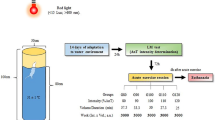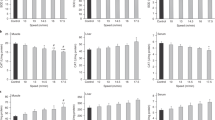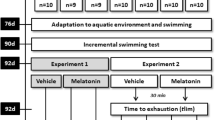Abstract
There are a few of studies examining how selenium, which is known to reduce oxidative damage in exercise, influences glucose metabolism and exhaustion in physical activity. The present study aims to examine how selenium administration affects liver glycogen levels in rats subjected to acute swimming exercise. The study included 32 Sprague–Dawley type male rats, which were equally allocated to four groups: Group 1, general control; Group 2; selenium-supplemented control (6 mg/kg/day sodium selenite); Group 3, swimming control; Group 4, selenium-supplemented swimming (6 mg/kg/day sodium selenite). Liver tissue samples collected from the animals at the end of the study were fixed in 95% ethyl alcohol. From the tissue samples buried into paraffin, 5-µm cross-sections were obtained using a microtome, put on a microscope slide, and stained with PAS. Stained preparations were assessed using a Nikon Eclipse E400 light microscope. All images obtained with the light microscope were transferred to a PC and evaluated using Clemex PE 3.5 image analysis software. The highest liver glycogen levels were found in groups 1 and 2 (p < 0.05). The levels in group 4 were lower than those in groups 1 and 2 but higher than the levels in group 3 (p < 0.05). The lowest liver glycogen levels were obtained in group 3 (p < 0.05). Results of the study indicate that liver glycogen levels that decrease in acute swimming exercise can be restored by selenium administration. It can be argued that physiological doses of selenium administration can contribute to performance.




Similar content being viewed by others
References
Shamberger RJ (1986) Selenium metabolism and function. Clin Physiol Biochem 4:42–49
Shu H (1989) Human selenium deficiency during total parenteral nutrition support (a case report). Zhongguo Yi Xue Ke Xue Yuan Xue Bao 11:74–76
Brown KM, Arthur JR (2001) Selenium selenoproteins and human healt: a review. Public Health Nutr 4:593–599
Neve J (1995) Human selenium supplementation as assessed by changes in blood selenium concentration and glutathione peroxidase activity. J Trace Elements Med Biol 9:65–73
Behne D, Wolters W (1979) Selenium content and gulutathıone peroxidase activity in the plasma and erythrocytes of non pregnant and pregnant women. J Clin Biochem 17:133–135
Holben DH, Smith AM (1999) The diverse role of selenium within selenoproteins: a review. J Am Diet Assoc 99:836–843
Olivieri O, Girrelli D, Azzini M (1995) Low selenium status in the elderly influences thyroid hormones. Clin Sci 89:637–642
Sen CK, Packer L (2000) Thiol homeostasis and supplements in physical exercise. J Am Clin Nutr 72:653–669
Thomson CD (2004) Assessment of requirements for selenium and adequacy of selenium status: a review. Eur J Clin Nutr 58:391–402
Jana K, Samanta PK, Manna I, Ghosh P, Singh N, Khetan RP, Ray BR (2008) Protective effect of sodium selenite and zinc sulfate on intensive swimming-induced testicular gamatogenic and steroidogenic disorders in mature male rats. Appl Physiol Nutr Metab 33:903–914
Fritsche L, Weigert C, Häring HU, Lehmann R (2008) How insulin receptor substrate proteins regulate the metabolic capacity of the liver–implications for health and disease. Curr Med Chem 15:1316–1329
Straczkowski M, Kowalska I, Górski J, Kinalska I (2000) The effect of a single bout of exhaustive exercise on muscle carbohydrate and lipid metabolism in a rat model of type 2 diabetes mellitus. Acta Diabetol 37:47–53
Petersen KF, Price TB, Bergeron R (2004) Regulation of net hepatic glycogenolysis and gluconeogenesis during exercise: impact of type 1 diabetes. J Clin Endocrinol Metab 89:4656–4664
Gehringer MM, Downs KS, Downing TG, Naudé RJ, Shephard EG (2003) An investigation into the effect of selenium supplementation on microcystin hepatotoxicity. Toxicon 41:451–458
Lohner TW, Reash RJ, Williams M (1995) Assessment of tolerant sunfish populations (Lepomis sp.) inhabiting selenium-laden coal ash effluents. 2. Tissue biochemistry evaluation. Ecotoxicol Environ Saf 50:217–224
Roden M, Prskavec M, Fürnsinn C, Elmadfa I, König J, Schneider B, Wagner O, Waldhäusl W (1995) Metabolic effect of sodium selenite: insulin-like inhibition of glucagon-stimulated glycogenolysis in the isolated perfused rat liver. Hepatology 22:169–174
Author information
Authors and Affiliations
Corresponding author
Rights and permissions
About this article
Cite this article
Akil, M., Bicer, M., Kilic, M. et al. Effect of Intraperitoneal Selenium Administration on Liver Glycogen Levels in Rats Subjected to Acute Forced Swimming. Biol Trace Elem Res 139, 341–346 (2011). https://doi.org/10.1007/s12011-010-8667-4
Received:
Accepted:
Published:
Issue Date:
DOI: https://doi.org/10.1007/s12011-010-8667-4




